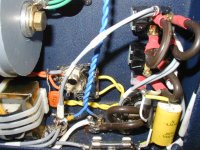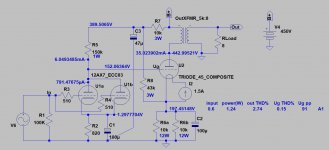Hey Jeff - how's a good switch any different, electrically speaking, from the contacts between tube pins and tube sockets ? - should all be good in the end if good parts are used, as you suggest.
Hi Bigun,
No no, adding a high quality switch is not like using a high quality socket. The switch is ADDED and not needed. The socket MUST be used.
On AC switches, I only will use heavy duty DOUBLE POLE DOUBLE THROW switches, and I routinely always parallel both sets of contacts, to get double the surface area, etc etc.
In my " personal amps " that I use at home, DIY, I also use a second switch ( DPDT ) so as to short out the AC fuse and GE CL-90 thermisor I use for start up. I use double 12 AWG wire to hook it up ( equals 9 AWG ). I call this my personal " attended listening " switch, totally illegal in a item for the public, but- to me - totally JOYFUL to me ears on these A7-800 VOTTs, playing in my living room.
On tube sockets, from 2015 on, I will only use WOO teflon four pin sockets on my DHTs, and I get them from Mike Percy.
I only use JJ 2A3-40s now a days as Finals, no more NOS Type 45s. 45s do some things real nice, but old stock 45 tubes ( likely NOT EMLs ) have a broad suck-out in the middle midrange that makes them sound sick versus JJs in the same amp, with NO adjustments. ie, the JJ 2A3-40s ATE my 45s, in my 45 DC SET, when using ALL 45 circuitry, ie: running the JJs at 27 mA Ia !!!!!.
Isn't THAT interesting. Heard it instantly on piano. My year-end 2016 build is to be an optimized dual mono JJ 2A3-40 amp. Parts are on order and in shipment.
Jeff
Attachments
Last edited:
About the cathode resistor
On schematics says 3000 Ohms for 2A3, for 45 tube swing how many the cathode resistor can be?
Plus the change on OPT impedance, any other change on sch for 45 tube?
There are NO easy answers to your question. The general design procedure is to carefully choose a ( conservative in my opinion ) plate dissipation rate, and a good operating point, for both the Driver tube and the Finals tube. Then, you determine overall B+ for that in the DC amp, and design for the basic voltages of the direct couple.
IMHO, MOST two stage DC tube amps I see use non-optimized operating points for their tubes, and typically, start with a too low value overall for their B+,. This guarantees mediocre op points. Both tubes depend upon the other, and "beg" to EACH be " spot on ".
If you try to make these already-compromised tube designs also do TWO Finals circuits in one, I question the value of the build.
How about if we discuss the Nobu Shishido circuit, ( the topic of this post originally ), and try to optimize that. STARTING with the tube op points?
What I am thinking is this : I do NOT mind using 1 mA. on each 12AX7 section as Nobu Shishido did, or even 0.43 mA. as Isamu Asano did, but what about their use of 150 VDC Ea ??? I think that Ea is simply too low, and that about 185 VDC Ea, give or take 5 VDC, will " eat " 150 VDC Ea for lunch, in this circuit. That is typically the way one will hear it.
If you want 250 VDC P-K on the 2A3 Finals tube, then you need to start with higher than 450 VDC of B+ to the Finals, to optimize BOTH tubes' operating points. Likely 490 to 495 VDC of B+, give or take 5 VDC, is needed.
How else can one elegantly optimize the Shishido DC 2A3 amp, without adding circuit complexity ??
Have fun, I am.
Jeff
Last edited:
Hi hobbyamp,2A3 Shishido L-W
About the cathode resistor
On schematics says 3000 Ohms for 2A3, for 45 tube swing how many the cathode resistor can be?
Plus the change on OPT impedance, any other change on sch for 45 tube?
I have Shishido Loftin-White 2A3 amp with Tango FS-20s power transformers and i have chematic which shows 3K ohms for Cathode resistors for 2A3 tube.
Transformers have taps for 45, 2A3 and 300B tubes and I'm wondering what would be the value of cathode resistor for 45 tube.
I see that you asked same question but I don't see if anybody gave you an answer.
Thanks in advance,
Ben

